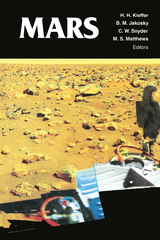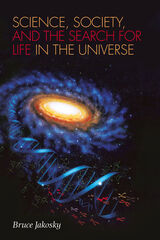2 books by Jakosky, Bruce M.

Mars
Edited by H. H. Kieffer, B. M. Jakosky, C. W. Snyder, and M. S. Matthews
University of Arizona Press, 1992
The planet Mars has been a subject of wonder for millennia, as attested by its place in mythology, by later speculation about its canals, and by the scientific and public excitement over the Viking mission. Although the scientific literature about the planet is voluminous, no comprehensive treatment of the results of modern spacecraft exploration has yet been made available. This volume fills that gap by providing a summary of what is presently known about Mars and identifying many puzzles such as polar cap variance, occurrence of dust storms, and the possible location of water. The introductory chapter cites questions, controversies, and milestones in the study of Mars, and also includes an annotated book list, basic data about the planet, and a guide to Martian seasons. A chapter on telescopic observation credits the contributions made by many amateurs that have advanced our knowledge of variations observed on Mars. A chapter on spacecraft exploration, by an American and a Russian author who have participated in all Mars missions, includes a revelation of an additional Soviet attempt. Twenty-nine technical articles cover geophysics; bedrock geology; surface; atmosphere; exosphere and magnetic field; and climate history. Two chapters address the search for life on Mars; three concluding chapters consider the Martian satellites. An indispensable reference for scientists, Mars will also serve as a complete sourcebook for serious amateur astronomers.
[more]

Science, Society, and the Search for Life in the Universe
Bruce Jakosky
University of Arizona Press, 2006
Are we alone in the universe? As humans, are we unique or are we part of a greater cosmic existence? What is life’s future on Earth and beyond? How does life begin and develop? These are age-old questions that have inspired wonder and controversy ever since the first people looked up into the sky. With today’s technology, however, we are closer than ever to finding the answers.
Astrobiology is the relatively new, but fast growing scientific discipline that involves trying to understand the origin, evolution, and distribution of life within the universe. It is also one of the few scientific disciplines that attracts the public’s intense curiosity and attention. This interest stems largely from the deep personal meaning that the possible existence of extraterrestrial life has for so many. Whether this meaning relates to addressing the “Big Questions” of our existence, the possibility of encountering life on other planets, or the potential impact on our understanding of religion, there is no doubt that the public is firmly vested in finding answers.
In this broadly accessible introduction to the field, Bruce Jakosky looks at the search for life in the universe not only from a scientific perspective, but also from a distinctly social one. In lucid and engaging prose, he addresses topics including the contradiction between the public’s fascination and the meager dialogue that exists between those within the scientific community and those outside of it, and what has become some of the most impassioned political wrangling ever seen in government science funding.
Astrobiology is the relatively new, but fast growing scientific discipline that involves trying to understand the origin, evolution, and distribution of life within the universe. It is also one of the few scientific disciplines that attracts the public’s intense curiosity and attention. This interest stems largely from the deep personal meaning that the possible existence of extraterrestrial life has for so many. Whether this meaning relates to addressing the “Big Questions” of our existence, the possibility of encountering life on other planets, or the potential impact on our understanding of religion, there is no doubt that the public is firmly vested in finding answers.
In this broadly accessible introduction to the field, Bruce Jakosky looks at the search for life in the universe not only from a scientific perspective, but also from a distinctly social one. In lucid and engaging prose, he addresses topics including the contradiction between the public’s fascination and the meager dialogue that exists between those within the scientific community and those outside of it, and what has become some of the most impassioned political wrangling ever seen in government science funding.
[more]
READERS
Browse our collection.
PUBLISHERS
See BiblioVault's publisher services.
STUDENT SERVICES
Files for college accessibility offices.
UChicago Accessibility Resources
home | accessibility | search | about | contact us
BiblioVault ® 2001 - 2024
The University of Chicago Press









